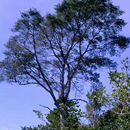en
names in breadcrumbs


The resins of this plant, which is also commonly known as Balsam of Peru, are a globally important commodity.
Myroxylon balsamum, Santos mahogany, is a species of tree in the family Fabaceae. It is native to tropical forests from Southern Mexico through the Amazon regions of Peru and Brazil at elevations of 200–690 metres (660–2,260 ft).[2] Plants are found growing in well drained soil in evergreen humid forest.
According to the Germplasm Resources Information Network, there are two varieties:[3]
The tree is large slow growing, reaching 45 metres (148 ft) in height. Crown is round with dense foliage and the bark is yellowish with a pungent odor. Leaves alternate, petiolate, 8–20 centimetres (3–8 in) including the petioles, the petioles 1–4 centimetres (1⁄2–1+1⁄2 in) long, and the rachis 5–15 centimetres (2–6 in) long. The rachis and petioles are pubescent and terete. Leaflets are acute to acuminate at the apex, obtuse at the base, glabrous, with an entire margin and glandular oil dots.
Plants bloom 5 years from seeds during the months of February to June. Flowers are white, pubescent and has around 10 stamens. The fruit is a flat winged pod, narrowly obovate 8 centimetres (3+1⁄4 in) long 1–2 centimetres (3⁄8–3⁄4 in) wide, yellow to brown when dried and drop around November to January.[4]
Balsam of Tolu and Balsam of Peru are the products of the species' resin. They are extracted from different varieties in different ways.[5][6] They are marketed among a series of intermediaries and exporters, their destinations being Germany, the United States of America, England and Spain, where they are used in the manufacture of cosmetics and medicines (for diseases of the skin, bronchi, lungs and airways, and in the treatment of burns and wounds).[7] The tree has been planted for Balsam production in West Africa, India, and Sri Lanka.
The wood is reddish and has interlocked grain, which gives it a strong ribbon-like pattern, and logs produce a large amount of knot-free lumber. The wood has a Janka hardness of 2,200 pounds-force (9,800 N) and is somewhat resistant to fungal decay. Myroxylon balsamum wood is used for flooring, furniture, interior trim, and heavy construction.[8]
M. balsamum is often used as a shade tree in coffee plantations.[4]
Myroxylon balsamum, Santos mahogany, is a species of tree in the family Fabaceae. It is native to tropical forests from Southern Mexico through the Amazon regions of Peru and Brazil at elevations of 200–690 metres (660–2,260 ft). Plants are found growing in well drained soil in evergreen humid forest.